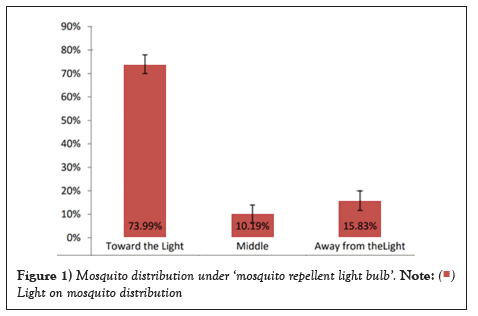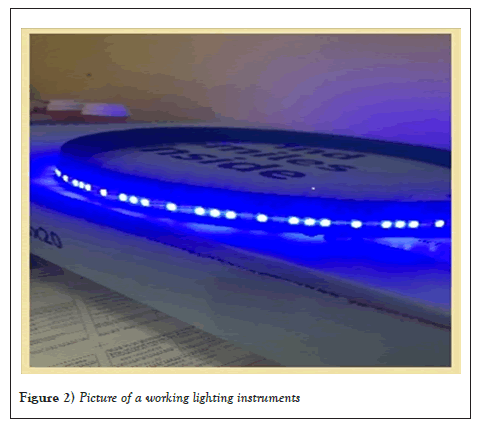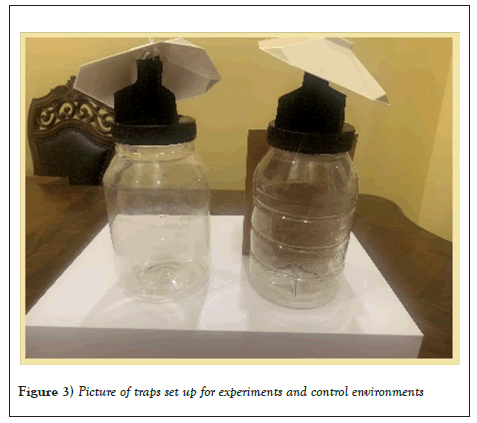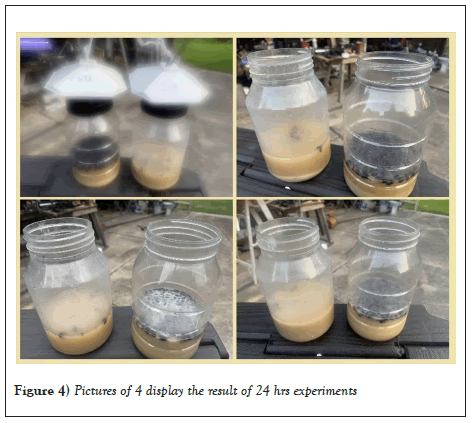Agricultural and Biological Research
RNI # 24/103/2012-R1
Research Article - (2023) Volume 39, Issue 5
Among insects, mosquitoes stand out as the most harmful. They cause millions of illnesses and hundreds of thousands of deaths yearly by transmitting bacteria and viruses into the human blood system through their bites. The second most harmful insects are flies, the most hated insects associated with dirtiness and illness from food poisoning.
With current technology, we can make a wheel-shaped LED light strip appear as if it is rotating around the circle, much like a rotating disco ball concept generating light spots that run into people. These light spots concepts can be minimized and applied to insects rather than people. Because the size of individual pixels of the strip is about the size of individual ball mirrors, the animation also generates similar running light spots. To scare insects away, these light spots must portray themselves as actively live, real, objects. Borrowing from our previous works on mosquitoes, we can make the ‘pixels ' light look authentic by changing its color at the right frequency. Only active, live, or living objects change their colors, size, and locations.
As a result of turning on the light, flies steered away from dinner and flocked to an identical meal out of sight.
Fly control; Mosquito control; Insect control; Malaria; Food poisoning
A survey of research articles in scientific journals covering the topic of insect prevention and control is consistent with the scientific process, which formulates a theoretical thesis and performs experiments to defend the finding and discovery. Experimentation is usually conducted by acquiring samples within laboratory facilities. The experimentation protocol is typically performed to compare the controlled and experiment environments [1].
Unlike many research works, this paper will not dive deep into the theoretical study but rather express the results and findings in laymen's terms. This is because building a dedicated laboratory is not cost-effective, and having access to a laboratory for such research is limited. Therefore, household and off-the-self building materials were used to design the experiment to provide quick, effective, and practical results. This paper’s goal is to present a new perspective in the field of insect and pest prevention control research accumulated over many years of product research, development, and experimentation [2].
Repelling is to force (something) to move away or apart, while the concept of insect repelling light is to introduce high -tech lighting instruments to mimic the comings of actively live-objects for the insects to “see”, to feel threatened. In animal kingdom, if you don’t see the threats then there is no threat and removing threats is not an option but the matter of survival, they only can do so by going to hide in the background or behind opaque objects; the out-of-sight areas. It’s not the same as going away or going further away for they are still in reach of the light [3].
More than 1 decade ago we set out to develop LED base lightning device to repel mosquitoes. It was based on the observations that in nature only live or living objects change color, also in nature the changes do not happen abruptly, except in the case of something passing over. Things of that nature have been with us long before then in movies, or videos Though their changing rates are slow in dozens frames per second, designed to create illusions in human minds. Our mosquito repelling instrument came to light when we have its colors change abruptly, in short intervals mean to be faster than the time they need to figure out the distances. The goal was to create illusions of chaotic live objects after live objects, in order to make the lights appear as visual threats, they went hiding out-of-sight. Upon successful field tests, small batches were built and distributed among family, friends, and acquaintances for feedback [4].
Besides the user feedback we provided the prototype mosquito repelling light bulb to be evaluated by an established, third-party laboratory with authoritarian credential recognized by scientific community: Molecular-vector Physiology Lab, New Mexico State University. The laboratory evaluated the prototype in a controlled environment and its experimentation was conducted on Aedes aegypti using well established taxis cage protocol. After four test runs the data shown 73.99% of the insects went toward the light, 10.19% neutral and 15.83 went opposite, As shown in Figure 1.

Figure 1: Mosquito distribution under ‘mosquito repellent light bulb’.  Light on mosquito distribution.
Light on mosquito distribution.
The report tells us that 73.99% mosquitoes will be drawn toward the light bulb at the far corner of an open yard, 15.83% to the opposite corner, leaving the yard largely empty. Given enough time those who are not in the vicinity corner of the light bulb, will eventually go there for they are still within the exposure of the light bulb, and the yard become a mosquito cleared area. The conclusions can go both ways right, for a person at the far corner, the light bulb draws mosquitoes (from the yard) to him, he will get swamped and bitten. Much the same as the conclusion in the report, the light bulb is a mosquito attracting apparatus. On the other hand, for a person in the middle of the yard, the light bulb draws, clears mosquitoes away from him (to the corner), he won’t get bitten, thus, the light bulb is a mosquito repelling instrument. According to the manufacturer, the discrepancies stemmed from the narrow viewing angle of the lightbulb that left a chunk of the background out of sight, their good hiding place. The conclusions are not one excluding the other but rather one making more sense of the other [5].
Armed with this knowledge of using light to repel and control mosquitoes, we obtained positive feedback from users with requests for an effective method on flies from those working in seafood industries. For it seemed ineffective on flies, obvious questions are: perhaps because the intensity of the light was not powerful enough? making it more powerful? It took years to keep our eye on the market waiting for if there is anything in that nature were offered for sale for, we can have our hand on. Then COVID. Even though it only worked within very limited distances [6].
The inspiration to find a solution for those suffering from fly bites lead us to our design that mimics an effect like a disco ball which generates light spots that run into its people on the dance floor. Some people would try to avoid the disco light on the dance floor when they first observe. The light which leads to the hypothesis whether flies will behavior in the same matter. We slowly progressed and fine-tuned a light suitable to prove this concept until we finally designed a light that is effective, simple, and easily deployable. The paragraphs below provide the details for our design, experimentation, and journey to discuss and defend our thesis [7].
Construction of the lighting instrument
The light instrument is constructed from an individually addressable 144-pixel LED strip (P/N:WS2811B) mounted on a round band. An Arduino Nano microcontroller is used to program and set up the LED strip in a 6-pixel repeat of 3 active pixels, a passive pixel, an active pixel, and a passive pixel as shown in Figure 2 below. Consideration was taken to account for the WS2811B startup time which is approximately 30 microseconds to light up a pixel, 4.32 milliseconds to light up the whole strip, making it 248 times per second color changing rate) The program instruction is set on a continuous loop to light up the active pixels, cycling from red, to green, and then blue. This simulates a three-revolution-per-minute rotating speed and directions. After much experimentation, the direction of rotation is tuned to every dozen step to ensure light spots would fall headfirst upon the insects [8].

Figure 2: Picture of a working lighting instruments.
Equipment and method
These experiments also used two off-the-shelf Fly Magnet Fly Traps, one representing the control and the other representing experimental environment. The manufacturer plastic label covers that were wrapped around the bottles are removed allowing the bottles to be transparent. As shown in Figure 3, the bottle on the right has a cardboard attached using double-sided tape to shield it from light beam. The bottle on the right represents the control environment whereas the bottle on the left represents the experimental environment. After setting up the apparatus, the two traps were hung outdoor at eye level. The bottles were positioned 4 ft high, 8 ft apart and 25’ away from the light instrument [9].

Figure 3: Picture of traps set up for experiments and control environments.
The experimentation was conducted knowing the potential health and hazards risks that are associated with these harmful chemicals. Special precautions were taken in advance to ensure the safety of personnel and environment. As shown in Figure 3 below, t the experiment can be unpleasant, obnoxious, and unhealthy perform carcasses mixing of the liquid baits. After the bait is set, a strong order is generated to attract the insects from far away. Our counting sample of carcasses ranged between 75 to 100 corpses within the controlled environment which is significantly more than the experimental environment. Furthermore, the sizes of carcasses were found to be twice the same as the size of household flies in most cases.
As illustrated in Figure 4, we conducted four experiments and have witnessed a consistently estimated count of more than 150 carcasses in control environment bottles and less than 5 in experiment environment bottles. In conclusion, the flies are attracted to both baits; however, the flies avoided the bait from the experimental environment due to the light instrument resulting an approximate 30 to 1 ratio effectiveness to reply to flies.

Figure 4: Pictures of 4 display the result of 24 hrs experiments.
Furthermore, the pictures demonstrate the effect of the light instrument that it has on the behaviors of the flies. The flies did not prefer and were not trapped inside the experimental bottle environment compared to controlled bottle experiment which was exposed to the light which the to the control bottle where the light was blocked [10].
Based on our observation
This solution relies on light instruments and is only effective when insects see it or within lines of sight. The trap bottles cast a shadow or dark area which flies can use as cover to shield from the light instrument. Contrary to common belief that the brighter the better means the closer the better, we discovered that in fact, the closer the subject is to the light, the larger the shadow, and the larger the area where the insects hide and feel safe to land.
A strategy to prevent flies from entering a house is to place a light instrument in the field of view of the porch. Besides deploying a single line, we recommend installing an additional fly trap nearby and out-of-sight trap. The nearby trap complements well with the light instrument allowing a reserved place for the fly to be attracted to the trap and avoiding the protected area, the porch or front door. A good rule of thumb is that if one can smell the trap, the flies can do so even better. For example, we have had the light installed in our front yard approximately 42 feet away shed and before our E.R incident, it has been more than 6 weeks since the day we were discharged, we only got one fly that came through the door of our kitchen.
In this experiment, we had fly traps setting 8’ apart from each other. The further they were from each other, the less striking the results. For example, at 20' separation, the count in the control bottle was reduced to about one fifth. Therefore, if one wants to clear flies out of an area, there should be a trap that is smelly and nearby, a reserved place for them to go and be trapped [11].
In proximity to the light, or at distances of less than 10', we had also observed that many flies will choose to “play dead,”. In other words, the flies stay stationary and do not move until they are physically touched.
The decade of experimentation and product development laid a solid foundation for this experiment. Furthermore, the experimentation is analogous to the tree truck and branches used to defend the thesis. Lastly, the ripe fruit is a metaphor for the theoretical thesis presented in this paper. The solution described in this paper is based on the principle of applying technology to imitate active, live objects that are running into and after flies, which are the subjects of this study. We know the method is effective on flies, and the light instrument is a deterrent forcing them to move somewhere else. In principle, the method should work on insects of other species. We usually try to scare away with a wave of a hand, such as mosquitoes, butterflies, love bugs, dragonflies, and honeybees, etc. Without any experiment on them done, we are unable to provide any experimental data to solidify this claim other than to provide observations from the field and formulating logical expectations for future work, the horizon is open from mosquitoes born disease control to agricultural pest control. The method cannot kill any insect; however, it can be used to change the population density in order to increase the effectiveness of other traditional method.
[Crossref] [Google Scholar] [PubMed]
[Crossref] [Google Scholar] [PubMed]
[Crossref] [Google Scholar] [PubMed]
[Crossref] [Google Scholar] [PubMed]
Citation: Tran P. Fly control: A simple visual perceptive method. AGBIR.2023; 39(5):634-636.
Received: 21-Aug-2023, Manuscript No. AGBIR-23-110791; , Pre QC No. AGBIR-23-110791 (PQ); Editor assigned: 23-Aug-2023, Pre QC No. AGBIR-23-110791 (PQ); Reviewed: 05-Sep-2023, QC No. AGBIR-23-110791; Revised: 12-Sep-2023, Manuscript No. AGBIR-23-110791 (R); Published: 19-Sep-2023, DOI: :10.35248/0970-1907.23.39.634-636
Copyright: This open-access article is distributed under the terms of the Creative Commons Attribution Non-Commercial License (CC BY-NC) (http:// creativecommons.org/licenses/by-nc/4.0/), which permits reuse, distribution and reproduction of the article, provided that the original work is properly cited and the reuse is restricted to noncommercial purposes. For commercial reuse, contact reprints@pulsus.com This is an open access article distributed under the terms of the Creative Commons Attribution License, which permits unrestricted use, distribution, and reproduction in any medium, provided the original work is properly cited.
